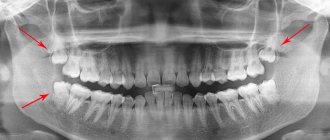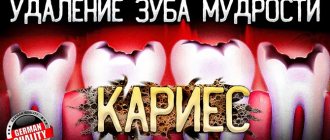No teeth cause as many controversial questions and answers as wisdom teeth. One of these questions is “What to do if caries appears in your wisdom tooth?” If doctors are unanimous regarding caries in all other teeth, then with regard to the eighth teeth, patients meet with different opinions from doctors. Some experts suggest removing wisdom teeth without hesitation, and some doctors offer treatment. What should a patient do in such a situation, because dentists, even incompetent ones, often speak very convincingly.
Features of caries on figure eight
The cause of this disease is the accumulation of bacterial plaque and poor hygiene. “Eights” erupt late, on average after 18 - 20 years, and sometimes remain partially unerupted (impacted). At the same time, wisdom teeth are located far in the oral cavity, and it is almost impossible to clean them properly. If part of the crown is located under the gum, a so-called gum hood is formed, where food particles easily fall, and the tooth is destroyed even faster. These factors are the main reasons for the appearance of caries on the figure eight.
Treatment of pathologies with the growth of eights
When a wisdom tooth grows, you should definitely consult a doctor, especially if there is pain or acute inflammation of the mucous membrane over its chewing surface. Consultation with a specialist is also required if pain of unknown etiology occurs - pressing, spreading throughout the lower jaw, appearing when chewing and opening the mouth. In such a situation, you need to take a panoramic photo to establish the exact cause of this condition - it is quite possible that the tooth is located inside the jawbone and is not externally noticeable.
If growth is accompanied by swelling and redness of the mucous membrane, gums moving away from the crown, and acute pain, maintenance therapy is necessary. It is extremely important for the patient himself to carry out the maximum possible oral hygiene - brush the growing wisdom tooth in the morning and evening, use an irrigator after each meal. It is this product that will most effectively remove food debris and bacteria, stopping inflammation.
In case of a serious inflammatory process, plastic surgery may be required to excise the hood - under local anesthesia, part of the gum is cut off, and the space is cleared of deposits. At the same time, drug therapy is prescribed, which will stop the inflammatory process and restore the condition of the tissues.
At the Smile-at-Once clinic, the issue of removing the 8th tooth is resolved strictly individually. We make sure to take a panoramic photo, which allows us to assess the position and degree of impact on the entire dentition. If there is an opportunity to save a tooth and treat it, the clinic’s doctors will definitely take advantage of it.
Symptoms of wisdom tooth caries
The main danger of the disease is that it is asymptomatic for a long time. And if the patient ignores regular preventive examinations at the dentist, he will learn about the problem at a deeper stage. For example, cervical caries of a wisdom tooth is often discovered only when the patient begins to suffer from sudden pain.
At first, a dark spot appears on the enamel, but it is difficult to see, because the tooth is located far away and at an angle. There is no pain because the enamel is devoid of nerve endings.
As the disease progresses, it continues to destroy the enamel and reaches the dentin. Here the first symptoms begin to appear - bad breath, and sometimes short-term pain under the influence of mechanical, temperature and chemical stimuli. You need to remember: if your wisdom tooth hurts, caries is most likely the cause.
Dentin is a porous tissue, so at the middle stage the disease begins to progress very quickly: demineralization of the tooth occurs and necrotic changes begin. Deep caries of a wisdom tooth is characterized by damage to hard tissues, which is why the tooth reacts strongly to hot and cold, sour and sweet. A prolonged aching pain occurs, the coronal part is severely destroyed.
In addition to location, dentists classify caries according to the depth of the pathology:
- The spot stage is considered the mildest. This type is easy to clean and saves the tooth from further damage.
- The superficial type of caries is characterized by the process of demineralization of tooth enamel with further destruction.
- Deep caries is characterized by irreversible destructive effects on the tooth due to the development of carious microflora. During the examination of the affected tooth, you can see a layer of dentin located between the pulp and the bottom of the carious cavity.
Based on the types of anatomical location, caries of dentin, enamel and cement is distinguished.
Wisdom tooth caries - treat or remove?
It is important to remember that the carious process cannot be left to chance even at the initial stage: the infection spreads quickly, and even healthy organs of the oral cavity can soon be affected. It's time to answer the question that torments many: if wisdom tooth caries is detected, what to do - therapy or removal?
Removal of a wisdom tooth with caries is indicated
- A wisdom tooth is a rudiment that is practically not used in the chewing process, and there is little benefit from it.
- Eights are located far away, access to them is limited, which makes it very difficult to provide quality treatment. This increases the likelihood of re-infection.
- The therapy is tiring for the patient because he has to sit with his mouth wide open throughout the entire procedure. This is especially true for the treatment of caries of the upper wisdom tooth.
As a rule, removal is indicated in cases where the tooth is dystopic and/or impacted, constantly injures the cheeks and tongue, and causes inflammatory processes due to difficult eruption. Whether to remove a wisdom tooth with caries, if it grows normally and does not cause any problems, should be decided individually together with a specialist.
Features of growth
Wisdom teeth are considered rudiments - organs that have lost their basic meaning. Previously, they were needed to chew tough foods. In the process of evolution, food became softer and softer, so the need for them gradually disappeared. Over time, the size of the jaw has also changed - it has become smaller, and now cannot accommodate four extra teeth.
Typically, wisdom teeth appear between the ages of 18 and 27. It has been proven that “eights” do not affect the chewing process in any way - a person can easily do without them. Some people don't have them at all, and that's normal.
Treatment of wisdom tooth caries
Despite the irrationality of preserving the eight tooth, sometimes the doctor recommends abandoning extreme measures and prescribes treatment for the eighth tooth.
Indications for removal of a wisdom tooth with caries
- Caries is at an early stage: the tooth can be saved, and treatment will not be difficult or expensive.
- The figure eight is involved in prosthetics - for example, it is a support for a bridge or clasp prosthesis.
- The tooth erupts normally, without deviations.
- There is an antagonist that will ensure uniform distribution of the chewing load.
- Removing a wisdom tooth with caries is contraindicated due to pregnancy or other reasons, but it is necessary to stop the spread of infection.
Therapy proceeds as follows:
- the affected tissue is removed with a drill;
- the resulting cavity is disinfected with antiseptic agents, an insulating gasket is placed on the bottom;
- the cavity is filled layer by layer with a composite material, which hardens under the influence of a photopolymer lamp;
- The shape of the tooth is adjusted using a drill so that it looks natural and ensures complete closure with the antagonist tooth.
So if you are wondering whether wisdom teeth cure tooth decay, then the answer is yes. However, it is important to consult a specialist in time and not to advance the disease.
Indications for removal
In some circumstances, removing the “eight” becomes the only way out. In particular, the doctor will decide to get rid of the eighth tooth if:
- It is located at an angle and when cutting through it puts pressure on the roots of its neighbors;
- A partially erupted tooth injures the gums;
- When affected by caries, the treatment area is difficult to reach;
- The roots of the "eight" grow in the maxillary sinus;
- The patient suffers from facial neuralgia;
- Complications developed;
- There is a gum cyst in the eruption area.
Deep caries of wisdom tooth
If the development of the carious process is not stopped in time, the infection will gradually penetrate deeper and eventually reach the pulp. Inflammation in the pulp tissue is called pulpitis and is accompanied by aching pain that is difficult to ignore. It is not easy to treat deep caries of wisdom teeth, since it is necessary to fill the root canals, and the roots of figure eights are usually curved. Untreated pulpitis can develop into more serious diseases - wisdom tooth cyst or periodontitis, which are much more difficult to combat.
Removal steps
The dentist removes the “figure eight” using the following technology:
- First, the doctor administers local anesthesia;
- The mucous membrane and periosteum are removed;
- A section of bone above the diseased tooth is cut out;
- The tooth is removed. In some particularly difficult cases, removal is carried out in parts;
- The periosteum, like the mucous membrane, is sutured;
- The hole is cleaned with an antiseptic and a tampon is placed.
Gradually, a bloody clot forms in the hole, protecting the wound from infection.
Possible complications
Depressions in the enamel themselves signal the presence of problems. If your hole in the tooth begins to hurt, even if not very much, it is recommended to immediately seek the help of a doctor. Otherwise, there will be a huge number of unpleasant consequences.
Among the most common types of complications are pulpitis and periodontitis. In the first case, there is simply acute inflammation of the dental nerve, with severe aching pain. In the second, the dental ligaments that secure the tooth to the bone are damaged.
Important! The main mistake that patients make is using a large number of analgesics. Despite the fact that they relieve pain, the process of decay in the tooth does not stop, and along with this, the death of the nerve occurs, which leads to complete loss of the tooth.
What causes a black hole to form in a tooth?
The main reason for the formation of holes in teeth, as already mentioned, is caries. Being a consequence of the activity of bacteria and microorganisms, it can lead to complete destruction of the tooth. Doctors note that there are many reasons for its appearance.
Important! According to statistics, women suffer from caries more often than men. This is associated with hormonal changes in the body that occur in women during pregnancy and lactation. In addition, people with malocclusions are more likely to develop cavities and holes in their teeth. Too narrow spaces between teeth, thinned enamel - all this contributes to the accumulation of food and the creation of a favorable environment for the development of microorganisms.
Types of anesthesia
Performing surgical interventions is impossible without high-quality anesthesia. During extractions, the following types of anesthesia can be used:
- infiltration anesthesia – provides a local effect. Injected with a syringe into the gum or intraosseously. This is the most common option for dental procedures;
- conductive - has a more powerful effect and is used when operating on particularly complex cases. The injection is carried out to the branches of the trigeminal nerve;
- intraligamentary - used to anesthetize one tooth. The medicine is injected with a syringe into the ligament that holds the tooth in the alveolus.
Expert opinion: Some patients want dental surgery to be performed under general anesthesia. But this type of anesthesia is not as harmless as it is described in advertising articles. It has been proven that it negatively affects the patient's health. An operation to remove teeth, even such complex ones as the “eight”, is not a direct indication for the use of general anesthesia (with rare exceptions). Surgery is painless with the correct selection of local anesthetic. Therefore, you should not strive for general anesthesia and put unnecessary drug burden on the body.
Stages of hole formation
The most common occurrence is the formation of a hole in a wisdom tooth. Inaccessible to cleaning with a regular brush, they become a convenient place for bacteria to accumulate. However, depressions in the enamel do not appear immediately; the last stages of caries development can be prevented if you constantly monitor the condition of your teeth. Let us briefly describe each of the progressive stages of caries development:
Initial stage: there is slight darkening on the tooth. To treat caries, it is enough to treat the affected area with a special solution, prescribe a diet, medicinal powders and toothpaste.
Superficial caries: there is slight destruction of the enamel without severe signs of pain. Slight roughness may be observed, and tooth sensitivity to cold and hot increases.
Middle stage: this is where the formation of depressions is diagnosed; not only the enamel is damaged, but also the dentin. Difficulties in brushing teeth and discomfort when eating sour, sweet or salty foods are noted. In this case, it is difficult to relieve pain even when taking analgesics.
Deep caries: the affected tooth cavity increases in size, the enamel is damaged over almost the entire area of the tooth, the dentin becomes softened. It is almost impossible to touch the tooth; there is complete damage to the neurovascular tissue.
What to do if there is a hole in your tooth?
If you notice the development of at least the first stage, immediately go to a visit to the dentist. The hole is the last stage of carious damage, which can be very difficult to get rid of. Professional treatment of holes is carried out only in a dental clinic. The standard work plan of a specialist usually includes:
- Treatment of the oral cavity (plaque and tartar on the diseased tooth are removed, normal hygiene procedures are carried out).
- Anesthesia of the hole site (if the disease is of significant complexity).
- Removal of areas of dental tissue affected by caries, treating them with an antiseptic drug.
- Drilling the required shape to install a filling in it; if necessary, a therapeutic pad is applied to provide an anti-inflammatory effect on the nerve.
- Sealing the treated cavity with filling material, the color of which fully matches the color of the tooth. After this, the filling is adjusted according to the bite, ground and polished.











